“The fact that we live at the bottom of a deep gravity well, on the surface of a gas covered planet going around a nuclear fireball 90 million miles away and think this to be normal is obviously some indication of how skewed our perspective tends to be.” -Douglas Adams
Even though our main blog has moved, I'm so glad that the questions and suggestions have still been pouring in, because it's time for another entry in our Ask Ethan series! Today's question comes from professional physicist Marty Olsson, who asks:
I have been bothered for a long time why the Milky Way looks curved, sort of like a rainbow... instead of straight like our galaxy is supposed to be.
I guess I don't understand the perspective. Is it because we are not in the galactic plane?
Now, Marty was kind enough to provide an example of exactly what he's talking about, and if you've been using the internet to find outstanding space photos, chances are you've come across something like this yourself.
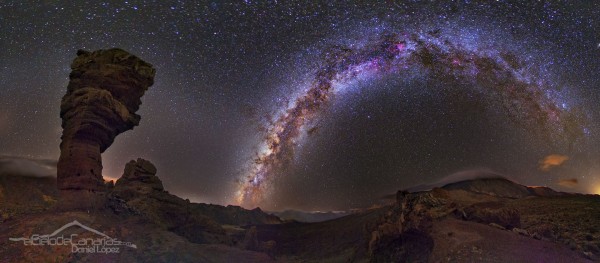 Image credit: Daniel López (El Cielo de Canarias), via http://www.elcielodecanarias.com/.
Image credit: Daniel López (El Cielo de Canarias), via http://www.elcielodecanarias.com/.
Now, I'm well aware that not everyone has actually seen the Milky Way themselves in real life; I myself have only seen it on three separate occasions, and none of those happened until I was already well into adulthood.
But when I've seen it, it's always looked like this.
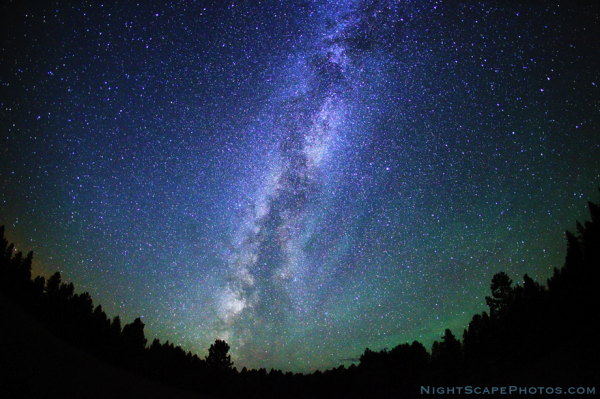 Image credit: IronRodArt - Royce Bair ("Star Shooter") of flickr, via http://nightscapephotos.com/.
Image credit: IronRodArt - Royce Bair ("Star Shooter") of flickr, via http://nightscapephotos.com/.
The thing is, the galaxy really is straight! The proposed explanation was actually reasonable, as the spiral arm structure of our galaxy is quite curved; were we significantly out of the galactic plane, we might indeed see something like the curvature of some spiral arms from our perspective.
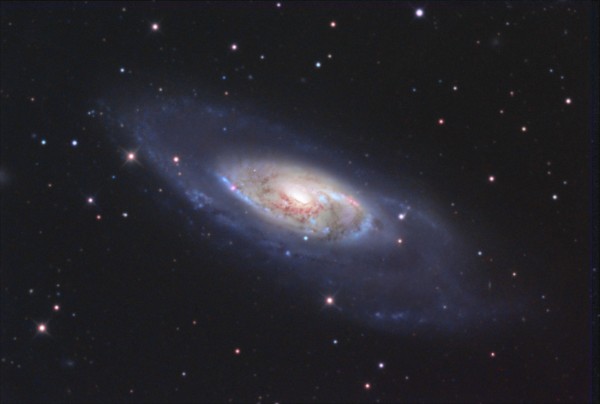 Image credit: user lebowski (Paolo) of the Ice In Space forum, via http://www.iceinspace.com.au/forum/showthread.php?t=72899.
Image credit: user lebowski (Paolo) of the Ice In Space forum, via http://www.iceinspace.com.au/forum/showthread.php?t=72899.
But we're actually pretty much smack in the middle of our galactic plane, and our galaxy is very much a flat, symmetric disk from our perspective. When we launched the COBE satellite -- rising above the Earth's atmosphere -- we were able to view the entire 360 degree galactic panorama in the infrared, and what we saw definitively showed what lay beyond the light-blocking dust of the Milky Way.
Our galaxy indeed has spiral arms, but we are in the galactic plane, and that plane is flat. So why, then, does it appear so curved in some images, when it just makes a straight (but huge) streak across the sky when we see it both with our own eyes and in some photographs?
The problem comes when we try and look at a larger region of sky than we can capture with a plain photograph and an undistorted lens. Take a look at this beautiful time-lapse video from the 2009 Texas star party, which was taken with a fisheye lens, and notice how some parts of what you see become more-or-less distorted as the time elapses.
What might help you get a handle on what's happening is a much simpler task: if you trace the Sun's path out over a day. No matter where on Earth you are, it travels in what appears to be a circle, only part of which is (usually) visible to an observer at a given location.
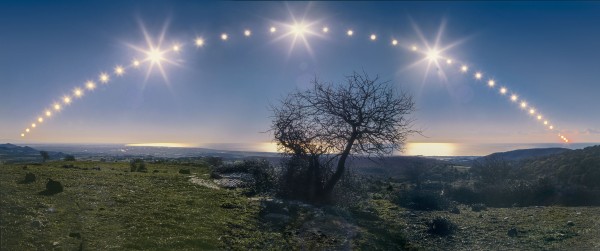 Image credit: Danilo Pivato of http://www.danilopivato.com/.
Image credit: Danilo Pivato of http://www.danilopivato.com/.
Yet I want you to think about what this image, above, shows. On the left side, that's the Sun rising in the east. Up atop the image, that's the Sun passing high overhead (this composition was created in Italy) in the southern part of the sky, and then towards the right, it sets in the west. Let me pose the following question to you:
How is it possible to get two points in the sky -- 180 degrees apart -- into the same image?
It's not possible, not unless you distorted something along the way! In this case, we had to distort the composite, stitched-together image in order to display the entire path with a flat horizon! This is a complicated task, similar to the reason why it's impossible to make a flat map of a sphere that simultaneously has all the properties you'd desire!
So what's the story of curved Milky Way panoramas, then?
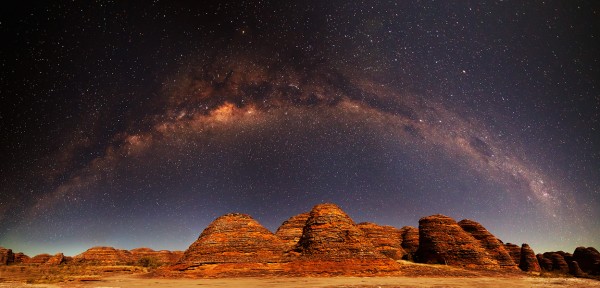 Image credit: Mike Salway of http://www.mikesalway.com.au/about/.
Image credit: Mike Salway of http://www.mikesalway.com.au/about/.
A beautiful shot like this -- created by Mike Salway, cofounder of the Ice In Space forum -- is not the result of a single shot, long-exposure photo, but rather the result of stitching together and then appropriately distorting a series of long-exposure images of the night sky. Mike was kind enough to detail the process publicly, and I wanted to walk you through some of the concepts involved.
First, here are the thirteen raw images used to stitch together this composite. Note how, in each one, the portion of the Milky Way that appears is completely straight, the way you'd see it with your own eyes.
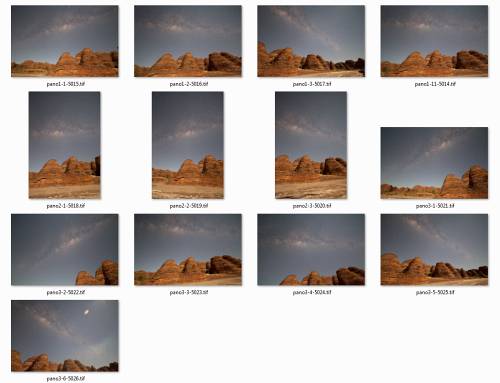 Image credit: Mike Salway, via his DIY tutorial at http://www.diyphotography.net/how-the-panorama-of-arching-milky-way-ove….
Image credit: Mike Salway, via his DIY tutorial at http://www.diyphotography.net/how-the-panorama-of-arching-milky-way-ove….
What you then need to do is stitch these images together, something that necessarily involves the creation of distortion, although not all that much. What you wind up with, though, is something that's not exactly pleasing to the eye to look at.
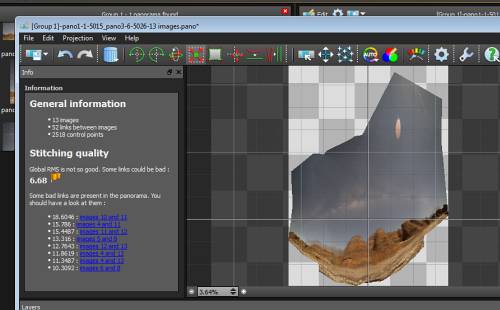 Image credit: Mike Salway's DIY tutorial, via http://www.diyphotography.net/how-the-panorama-of-arching-milky-way-ove….
Image credit: Mike Salway's DIY tutorial, via http://www.diyphotography.net/how-the-panorama-of-arching-milky-way-ove….
You see, we know that the horizon has got to be straight, and so when we see something like this, it offends our sensibilities. Distortion is always going to be greatest around the edges; after all, we're projecting a portion of a "sphere" (which is what we can see) onto a flat surface!
So you go to an editor, like photoshop or lightroom, and you apply a severe distortion to the image to flatten that horizon. This works, but it also heavily distorts the sky!
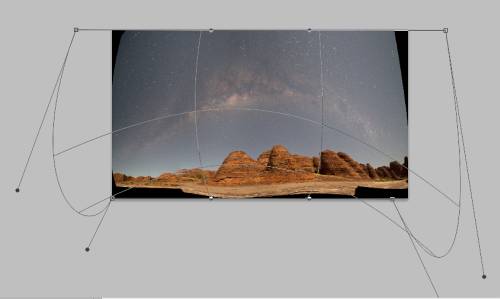 Image credit: Mike Salway's DIY tutoria, via http://www.diyphotography.net/how-the-panorama-of-arching-milky-way-ove….
Image credit: Mike Salway's DIY tutoria, via http://www.diyphotography.net/how-the-panorama-of-arching-milky-way-ove….
So in the end, you wind up with a very aesthetically pleasing image, and you can see two points 180 degrees apart (or more) at once, but the tradeoff? Your sky is tremendously distorted, although it's beautiful, and you can see far more of it than you otherwise could.
And this isn't even the worst of it: try going for a full 360-degree panorama!
If you want to capture the zenith -- directly overhead -- you have no choice but to deal with the most spectacular of distortions, the same way the poles of a sphere get distorted in a Mercator projection.
But the full 360-degree view is worth it; you just need to remind yourself that what your looking at is distorted in a very particular fashion. It's not the galaxy that's curved, but rather the image, so that we can view it all at once on a flat surface!
 Image credit: ESO/H.H. Heyer, access the full version here: http://www.eso.org/public/images/vlt-mw-potw/.
Image credit: ESO/H.H. Heyer, access the full version here: http://www.eso.org/public/images/vlt-mw-potw/.
And that's why the most beautiful photos of the night sky look like this! Thanks for joining me for another Ask Ethan, and don't forget to check out all the great posts on the new Starts With A Bang; you won't regret it!

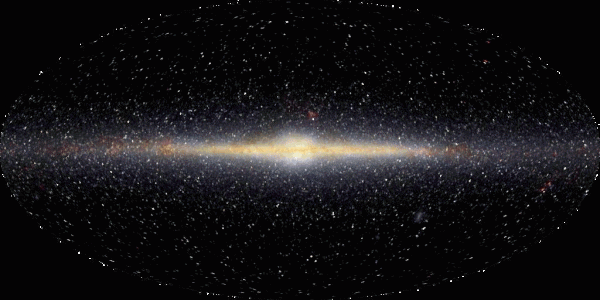
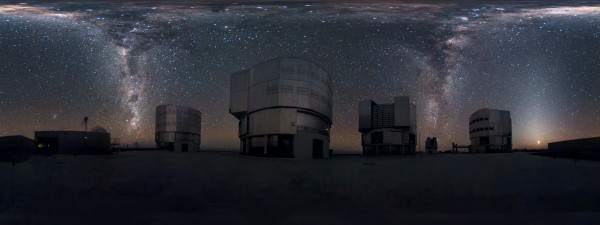
Well this is super cool!!
Nice article Ethan.
But why the new Starts with a Bang blog? And is there any provision for comments there? If not, I think that's a mistake myself.
John,
Are you asking me why I moved my blog to a new location? There were a lot of reasons, but it would be unprofessional for me to go into greater detail than I did in my introductory post there.
If you want to comment, you do need a twitter account, but that's no more invasive (to me) than asking for an email address. (As in, if you don't want to give one, just create a new one like you would with an email account -- it takes about 30 seconds -- and then comment using that.)
Your comment will appear to me and you first, and if I approve it (and I've approved every one that hasn't been spamvertising so far) the whole world can see it. It allows direct replies as well.
truly amazing!
I was just thinking about this the other day - thanks for explaining!
Well 30 seconds turned into an hour.
Twitter is not such a simple thing; if you want to maintain privacy and use a variable handle (e.g. OKThen)
But I finally figure out how to create a twitter account that retained my OKThen handle. My first post is over there. Assuming of course that Ethan approves it.
But now I need to figure out how to follow Ethan's posts on his new blog.
I assume that Ethan's new blog will take over from this old blog eventually; and that for now posts are in both places. Maybe? I'm not sure.
Because I don't know how to find Ethan's posts over there yet.
For example, I can't find THIS post over there.
So are we talking about parallel Ethan blog universes that are slightly different and both will evolve separately or what?
It's a new blog OKThen... guess you missed the news. This is one doesn't exists any more and will only be updated with "Ask Ethan" posts. The new one is new and fresh. There is no mirroring of posts
The big problem with the new blog is the incredible number of cookies it sets. Takes forever to approve and then remove them.
I was surprised he thought the Milky Way looked curved, until I realized, he's looking at distorted photographs. When I lived in Santa Ynez we had high desert climate, so star gazing on moonless nights was excellent, you could easily see the Milky Way overhead in the cold dry air.
Off topic, but I'm disappointed your new digs require Twitter to comment. It might be easy for someone who already has and uses Twitter, but I'm not one of those people, and I don't ever plan on having a Twitter account, so I'm out of the mix. Was there some reasoning behind the decision to use Twitter? Why not a more inclusive system?
Ethan: Thanks. I was asking about blogs because I'm thinking of setting one up myself. I logged onto twitter and medium easily enough and left a comment. Rather vacuous I'm afraid!
Same off-topic: No Twitter for me, or Facebook, or Google-related accounts, due to work-related security issues I can't discuss further. So if you move to a platform that requires Twitter, you lose me. It's been good, but "duty before pleasure," so, fare thee well.
Does anyone still reading this blog know why the text on the new blog appears much larger than on this old one? Many other sites seem that way too. Much page resizing involved.
@MandoZink
because certain developers think people primarily view websites from mobile phones and tablets. I don't like this trend at all, but there it is.
Sorry, but I'm not satisfied with your explanation as to why the Milky Way appears arched. If you are looking at the Milky Way on a May's night in the country where there are no buildings, you can even see the Milky Way appear as a circular band around the horizon around you. And remember, the Ancient Greeks referred to it as the milky circle not the Milky Line. Here's a question for you. If the Milky Way was indeed more like a planetary nebula, how would it appear to us if our planet was located in the center of the ring but a bit below it? The answer is it would appear exactly as it appears on May evenings -- as a ring around our horizon all around.
Great article- thank you
Drove me crazy seeing those pics of the galaxy as it is no as easy to guess what is happening like one sees a composite of the sun across the sky!
I am purist- the should caption this is amalgam of many shots else common public and young kids will be confused...
Wonderful Imagery!!! I don't care how it's put together, the fact that it is so beautiful just floors me!! I have seen the Milky Way one time in my life and I loved it!!!!
Thanks for this amazing explanation. I found myself looking at a similar Bing picture which was gorgeous, but I was troubled by the arch effect which I assumed must be a distortion and I wished I knew for sure. Now I do.
Thank you very much for explanation. I was confuse regarding this curvy "Milky Way" thing.